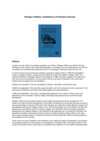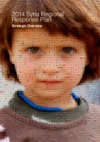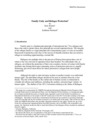Refugees Magazine Issue 95 (The international year of the family) - Help for single-parent refugee families
With 80 percent of all refugees either women or children, the number of refugee households headed by females is huge.
With 80 percent of all refugees either women or children, the number of refugee households headed by females is huge.
By Robin Ellis
One night in 1986, a five-member Afghan refugee family living in Delhi, India, was turned upside down when the husband mysteriously failed to come home. He was never heard from again.
For his wife, Jahan Ara, life took a dramatic turn for the worse after her husband's disappearance. She was unable to go out to work because she couldn't leave her three children - whose ages ranged from two to six years old - by themselves. In addition, her husband had always been the family wage-earner and she had no outside work experience.
The children cried at night for their father, and Jahan felt alone and increasingly desperate. She had no relatives in India, and the only other Afghan refugees whom she knew in Delhi were all men. While several of them tried to help, she had to be careful about being seen with them, for the sake of her reputation. There were no Afghan women around to lend her support.
After six months, in accordance with customary practice at the time, the local UNHCR office reduced the amount of financial assistance it was providing to the family on the basis that there was now one less mouth to feed. This undoubtedly added to Jahan's burden.
In March 1987, Kiran Bahl, a UNHCR medical social worker in Delhi, was informed that Jahan Ara had been admitted to hospital the previous night with third degree burns, possibly self-inflicted. Her condition was critical. Bahl immediately rushed to the hospital, where the young woman pleaded with her not to allow her children to be put in an institution, but instead to send them to her elderly father back home in Afghanistan. By the following morning, Jahan Ara was dead.
Today, as UNHCR and other agencies focus much more attention on the special needs of refugee women and children, a similar case would, hopefully, have a less disastrous outcome. It is now regular practice, even during major refugee emergencies, to attempt to identify vulnerable families headed by women as quickly as possible, both to protect them from possible harassment and to make sure they are receiving sufficient practical and emotional support.
The fate of Jahan Ara's three orphaned children was in the end not quite as bad as it might have been. UNHCR's offices inside Afghanistan were able to locate the children's grandfather. He was living, along with other members of his family (including several women), in an area that was free of fighting. As he was more than happy to take on the responsibility of bringing up his orphaned grandchildren - and was in a position to do so - UNHCR flew them to Mazar-i-Sharif in northern Afghanistan, where, in a very emotional scene, they were formally handed into his care.
Before the tragic chain of events sparked off by the sudden disappearance of Jahan Ara's husband, her family had been in a relatively fortunate position compared to many other refugee families (although the lack of any members of her extended family played a major role in what was to follow). A large number of refugee families lose one or several members before or during their flight. With 80 percent of all refugees either women or children, the number of refugee households headed by females is huge.
Refugee mothers, especially those with small children, face a wide range of difficulties if they are without husbands or other adult male relatives. Trying to care for small children single-handed, with little or no income, in a strange country that often has a radically different culture and language, while at the same time coping with personal grief and anxiety can make day-to-day problems seem totally overwhelming.
Ironically, life for a single woman with children can be easier in a refugee camp than it is in a city, where other refugees are less easily accessible. "Urban refugees sometimes do not even know where other people from their country are living in the same city," said Marie Lobo, UNHCR's senior social services officer in Geneva. "Urban refugees lack the support of friends, family and community. Single women with children, in particular, miss the help and comfort provided by other women." Moreover, it can be extremely difficult for UNHCR and other relief agencies to identify those who are most in need in cities.
Nowadays, UNHCR is trying to assist single mothers in more constructive ways than was sometimes the case in the past. Community workers and non-governmental organizations (NGOs), experienced at working in a particular city, are often used to help identify at-risk families, such as Jahan Ara's, that need special assistance and information to help them start rebuilding their lives.
One example of UNHCR efforts to identify those with special needs is the stand-by emergency arrangements with Radda Barnen, a Swedish NGO. During the early stages of a refugee emergency, trained community workers from Radda Barnen are sent to the scene with the specific objective of identifying at-risk populations and setting up initial arrangements designed to prevent problems that, if left unchecked early on, might easily spread out of control. One of the first things these community workers look into is the needs of mothers who have no spouse or relatives to support them. They also attempt to identify skilled people among the refugees - doctors, nurses, technicians - who can be immediately employed to good effect, and to develop community support systems to help identify and advise those in need, such as single-parent families.
While significant advances have been made in the management of emergencies over the past few years, urban refugees still pose a major challenge. In Moscow, for example, there are refugees from at least nineteen different countries scattered around the city. Many of them do not speak Russian. Among them are many single mothers, living far from their homes and totally without support.
"There is general poverty on the streets - the women, children and elderly have started to beg. Some people do not have enough money for a whole loaf of bread and have to buy half or quarter loaves," said Yvette Stevens, chief of UNHCR's Programme and Technical Support Section, who recently returned from Russia. "Refugees are among the worst affected, and some are forced to live in public places, such as railway stations."
One way to alleviate the problems facing urban refugees, especially female-headed families, is to establish a community centre. Plans are being drawn up for one in Moscow. "A community centre, ideally one which is accessible to all refugees, can help people find support, information, and most importantly, meaningful friends," said Stevens. In Moscow, for example, language classes in Russian, a library, a soup kitchen, child care, and primary health care could all be provided under one roof. Refugees would at last have somewhere to go, somewhere to meet people with whom they have something in common.
Community centres of this type have a proven track record, and have been growing more and more popular since they started being developed in the early 1980s. There are now dozens scattered in major cities around the world. Usually run by NGOs with the assistance of UNHCR, they provide a much-needed lifeline for urban refugees, and are particularly helpful to single women with children. The mutual support which invariably springs from meeting others gives people hope. More importantly, by taking it in turns to be responsible for child care, all the women are given the opportunity to undertake activities that are very difficult, if not impossible, to do while constantly looking after small children.
Refugees of both sexes can trade their skills to help each other. For example, as there are often teachers among refugees, the children can start receiving education at very little cost, in much the same way as education is set up in refugee camps. A centre makes learning possible not only for the children but also for adults, who can learn useful skills from each other, which they would be unable to do out on the street. The older women teach inexperienced younger women how to cope with pregnancy and looking after young children. They may also teach them income-generating skills such as knitting or embroidery, and help each other to find work.
One of the biggest aids to single mothers is to provide them with a source of income - either through job placement or home-based activities which enable them to earn some money. In Iran, UNHCR provided groups of Afghan women with a one-time supply of thread to weave traditional carpets - traditional carpets for the region, but beautiful and highly valued elsewhere. "The women would weave nearly every day - at home or in a group. After selling a carpet, they used part of their share of the earnings to buy necessary items - usually food, clothes, and shoes," said Omar Bakhet, UNHCR's former representative in Iran. "The rest of the money was spent on new cloth and threads with which to weave the next carpet and so perpetuate the source of income."
In Hungary, refugee women from former Yugoslavia unravelled old sweaters and knitted new ones, as well as blankets and shawls to keep themselves warm, or to sell in the market.
One problem that persists is the question of financial assistance - an issue UNHCR has yet to come fully to terms with. UNHCR only provides a small financial grant for a short time to families in need. Moreover, this money is given out on a sliding scale, based on family size. In the case of Jahan Ara, the disappearance of her husband led to a cut in the amount of assistance, when if anything her needs became greater. How can financial assistance be provided in a more sensitive, more carefully targeted way? Can extra funds be raised to ensure that truly needy families do not slip through the safety net? Are donors fully aware of the importance of flexible financial assistance and income-generating projects? Such questions still need to be addressed both within UNHCR and by other agencies and the donor community. At the moment, these types of non-emergency assistance are the first to be cut back when programmes are squeezed by lack of funding.
The number of problems that face a refugee mother without a husband to help her support the family is daunting. UNHCR is striving to do more to meet the special needs of single women and their families. Understanding those needs, and instilling a fierce commitment to provide a viable home environment for such women and their children, whether that home is a tent or some small corner of a strange and bewildering city, are the first steps in providing assistance in a dignified and appropriate way. Since Jahan Ara's death in 1987, there has been much progress. But a great deal remains to be done.
Source: Refugees Magazine Issue 95 (1994)
Your search for « help for single-parent refugee families » matched 204 results. Displaying page 1 of 23 pages.
-
Refugees Magazine Issue 95 (The international year of the family) - Help for single-parent refugee families
1 Mar 1994 ... One night in 1986, a five-member Afghan refugee ... While several of them tried to help, she had to be careful about being seen with them, for ... identify vulnerable families headed by women as ...... -

Refugee Children: Guidelines on Protection and Care
1 Jan 1994 ... ... and donor States on refugee children: What are the ... For example, in the chapter on Psychosocial Well-being we ... to support families there is a paragraph on extra help to single-parent families. ...... -

Refugee Children: Guidelines on Protection and Care
1 Jan 1994 ... ... and donor States on refugee children: What are the ... For example, in the chapter on Psychosocial Well-being we ... to support families there is a paragraph on extra help to single-parent families. ...... -

2014 Syria Regional Response Plan RRP6, January-December 2014
16 Dec 2013 ... ... to urgently help prevent a “Lost Generation”. A majority of refugee families struggle to obtain ... put food on the table for their families and ... conditions, single parents, people with ...... -

"Family Unity and Refugee Protection"
22 Oct 2001 ... can restore a refugee to something approximating a normal life. ... of separation from their families. For individuals who, as refugees, ... The self-help efforts of the refugee family multiply the efforts ...... -

DAFI Annual Report 2018
Jun 2019 ... Ensure you are using what you have to help others. 3. Build ... UNHCR: 1. Facilitate more leadership opportunities for refugee youth ... for themselves and their families, make informed life choices ...... -

DAFI Annual Report 2018
Sep 2019 ... Ensure you are using what you have to help others. 3. Build ... UNHCR: 1. Facilitate more leadership opportunities for refugee youth ... for themselves and their families, make informed life choices ...... -

DAFI Annual Report 2018
Sep 2019 ... Ensure you are using what you have to help others. 3. Build ... UNHCR: 1. Facilitate more leadership opportunities for refugee youth ... for themselves and their families, make informed life choices ...... -
Refugees Magazine Issue 95 (The international year of the family) - Year of the family
1 Mar 1994 ... But for millions of refugee families around the world, those foundations have been ... to help identify those most in need - often the elderly, unaccompanied children, the disabled, and single-parent ......
